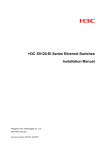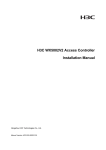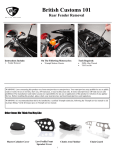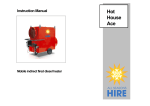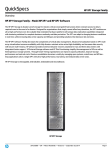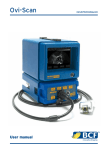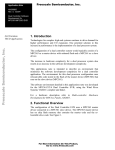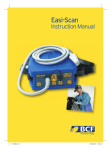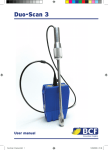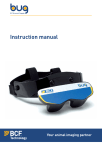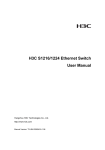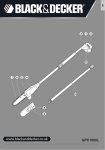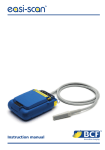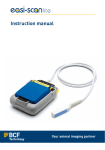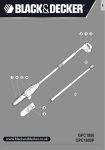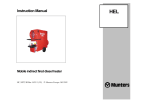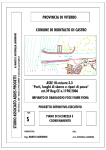Download LEDs - H3C
Transcript
H3C Neocean VX1500 Series Network Storage System Installation Manual Hangzhou H3C Technologies Co., Ltd. http://www.h3c.com Manual Version: AP103-20090305 Copyright © 2008-2009, Hangzhou H3C Technologies Co., Ltd. and its licensors All Rights Reserved No part of this manual may be reproduced or transmitted in any form or by any means without prior written consent of Hangzhou H3C Technologies Co., Ltd. Trademarks H3C, , Aolynk, , H3Care, , TOP G, , IRF, NetPilot, Neocean, NeoVTL, SecPro, SecPoint, SecEngine, SecPath, Comware, Secware, Storware, NQA, VVG, V2G, VnG, PSPT, XGbus, N-Bus, TiGem, InnoVision and HUASAN are trademarks of Hangzhou H3C Technologies Co., Ltd. All other trademarks that may be mentioned in this manual are the property of their respective owners. Notice The information in this document is subject to change without notice. Every effort has been made in the preparation of this document to ensure accuracy of the contents, but all statements, information, and recommendations in this document do not constitute the warranty of any kind, express or implied. Technical Support [email protected] http://www.h3c.com About This Manual Organization H3C Neocean VX1500 Series Network Storage System Installation Manual describes hardware features, device installation, cable installation, system startup, and troubleshooting for the H3C Neocean VX1500 network storage system (hereinafter referred to as the VX1500). Before installing the components of the VX1500, read this manual carefully so as to avoid possible equipment damage or personal injury. This manual is organized as follows: Chapter Contents 1 Product Overview Describes the components of the VX1500. 2 Preparing for Installation Describes the preparations and precautions for installing the VX1500. 3. Installing the VX1500 Describes the method of installing a VX1500 and the cables. 4 Setting Up Initial Configuration and Displaying Startup Information Describes the initial configuration and startup information of the VX1500. 5 Troubleshooting Describes the possible problems during the installation and startup of the VX1500 and the solutions. Appendix A Labeling and Routing Cables Provides guidance on how to use labels and route cables. Appendix B Compliance and Safety Manual Provides regulatory compliance information and safety information. Intended Audience This manual assumes that the reader has the basic knowledge of network storage systems. It aims to familiarize storage system administrators with hardware features of the VX1500 components, and to provide guidance for the installation of the VX1500 and its cables. Conventions The manual uses the following conventions: GUI conventions Convention Description Boldface Window names, button names, field names, and menu items are in Boldface. For example, the New User window appears; click OK. > Multi-level menus are separated by angle brackets. For example, File > Create > Folder. Symbols Convention Description Means reader be extremely careful. Improper operation may cause bodily injury. Means reader be careful. Improper operation may cause data loss or damage to equipment. Means a complementary description. Related Documentation Manual Description H3C Neocean VX1500 Series Network Storage Management Software User Manual Describes how to use the Neocean NeoStor console, the storage management software interface for the VX1500, to manage storage resources. H3C Neocean DE1116 Disk Enclosure Unit Installation Manual Describes the chassis, PSUs, heat dissipation system, LEDs and technical specifications of the DE1116 disk enclosure unit, and guides you to install the DE1116. Obtaining Documentation You can access the most up-to-date H3C product documentation on the World Wide Web at this URL: http://www.h3c.com. The following are the columns from which you can obtain different categories of product documentation: [Products & Solutions]: Provides information about products and technologies. [Technical Support & Document > Technical Documents]: Provides several categories of product documentation, such as installation, configuration, and maintenance. Documentation Feedback You can e-mail your comments about product documentation to [email protected]. We appreciate your comments. Environmental Protection This product has been designed to comply with the requirements on environmental protection. For the proper storage, use and disposal of this product, national laws and regulations must be observed. Declaration This is a Class A product. In a domestic environment this product may cause radio interference in which case the user may be required to take adequate measures. Table of Contents 1 Product Overview ······································································································································1-1 Introduction ·············································································································································1-1 Physical Description································································································································1-1 LEDs························································································································································1-4 Power Supply System ·····························································································································1-6 Heat Dissipation System ·························································································································1-7 Technical Specifications··························································································································1-7 2 Preparing for Installation ··························································································································2-1 Safety Recommendations·······················································································································2-1 General Safety Recommendations ·································································································2-1 Safety Recommendations with Electricity ·······················································································2-1 Safety Recommendations for ESD Prevention ···············································································2-1 HDD Usage Guidelines ···················································································································2-2 Safety with Device Moving ··············································································································2-2 Examining Equipment Components········································································································2-2 Preparing Installation Tools and Meters ·································································································2-2 Examining the Installation Site················································································································2-2 Temperature Requirements ············································································································2-2 Humidity Requirements ···················································································································2-3 Heat Dissipation Requirements·······································································································2-3 Cleanness Requirements ················································································································2-4 EMI Prevention ································································································································2-4 Grounding Requirements ················································································································2-5 Power Supply Requirements···········································································································2-5 3 Installing the VX1500·································································································································3-1 Installation Flowchart ······························································································································3-1 Verification Before Installation ················································································································3-1 Installing the Accessories ·······················································································································3-2 Installation Flowchart·······················································································································3-2 Installing Power Cable Latches ·······································································································3-3 Attaching the Mounting Brackets to the Main Chassis····································································3-5 Verifying the Installation ··················································································································3-5 Mounting the Chassis in a Standard 19-inch Rack·················································································3-6 Mounting the Main Chassis ·············································································································3-6 Mounting the Expansion Chassis ····································································································3-9 Connecting the SAS Cable··············································································································3-9 Verifying the Installation ··················································································································3-9 Mounting the Chassis on a Tabletop ····································································································3-10 Mounting the Main Chassis ···········································································································3-10 Installing the Expansion Chassis···································································································3-10 Connecting the SAS Cable············································································································3-10 Verifying the Installation ················································································································3-11 Installing Hard Disk Drives ····················································································································3-11 i Verification Before Installation·······································································································3-11 Installation Procedure····················································································································3-12 Verifying the Installation ················································································································3-14 Grounding the VX1500··························································································································3-14 Grounding Methods Available with the VX1500············································································3-14 Grounding the VX1500 in Different Environments ········································································3-15 Verifying the Grounding·················································································································3-17 Connecting Power Cables ····················································································································3-18 AC Power Sockets·························································································································3-18 Connecting Power Cables ·············································································································3-19 Verifying the Installation ················································································································3-20 4 Setting Up Initial Configuration and Displaying Startup Information ··················································4-1 Setting Up the Configuration Environment······························································································4-1 Setting Up the Configuration Network ·····························································································4-1 Configuring the Network ··················································································································4-3 System Startup and Startup Information·································································································4-6 Verification Before Power-on···········································································································4-6 Powering On the System·················································································································4-6 Displaying the Startup Information ··································································································4-6 Setting Up Initial Configuration ·············································································································4-11 Verification Before Configuration···································································································4-11 Assigning IP Addresses to Service/Management Ports································································4-11 Naming the NeoStor Server ··········································································································4-12 5 Troubleshooting ········································································································································5-1 Troubleshooting the HyperTerminal········································································································5-1 No Display on the HyperTerminal ···································································································5-1 Garbled Characters on the Console Terminal·················································································5-1 Maintaining the PSUs······························································································································5-1 Troubleshooting the PSUs ··············································································································5-1 Replacing a PSU ·····························································································································5-2 Maintaining the Hard Disk Drives············································································································5-4 Troubleshooting the Hard Disk Drives·····························································································5-4 Replacing a Hard Disk Drive ···········································································································5-4 Troubleshooting HDD Slots ····················································································································5-6 ii 1 Product Overview Introduction The H3C Neocean VX1500 Series Network Storage Systems are IP SAN storage products initially launched for H3C IP video surveillance (H3C iVS) solutions. The product specifications of the VX1500 series are provided in section “Technical Specifications” on page 1-7. To expand the disk capacity of your VX1500 products, you can use DE1116 disk enclosure units (DEUs). For the technical specifications and installation procedure of DE1116 DEUs, refer to H3C Neocean DE1116 Disk Enclosure Unit Installation Manual. Physical Description The VX1500 comprises a main chassis, hot-swappable power supply units (PSUs), hot-swappable hard disk drives (HDDs), and if expanded, a DE1116 DEU expansion chassis. The following are the front and rear views of a VX1500 system without expansion. For the views of a DE1116 DEU, refer to H3C Neocean DE1116 Disk Enclosure Unit Installation Manual. The front and rear views of the VX1500 are provided in this manual only for your reference. In this manual, “front”, “rear”, “left”, and “right” are defined with the front of the chassis facing the operator. 1-1 Front view of the VX1500 without expansion Figure 1-1 Front view of the VX1500 without expansion (1) (2) (3) (1) Power/ID/activity LED of the HDD (3) Disk size and rotating speed label of the HDD 1-2 (2) Fault/array status LED of the HDD Rear view of the VX1500 without expansion Figure 1-2 Rear view of the VX1500 (1) PSU blank panel (4) RAID processor management Ethernet port (7) GE service port 2 (10) Reset button (13) System power LED (16) Two USB interfaces (19) RAID processor management serial port (2) PSU (3) ESD jack (5) SAS interface (6) GE service port 1 (8) Ground screw (11) ID LED (14) Serial port 2 (17) FE management port (9) Power button (12) Alarm LED (15) Serial port 1 (18) SAS interface LED (20) PSU LED (21) AC power socket Table 1-1 describes the functions of the modules, interfaces, LEDs, and buttons on the rear panel of the main chassis: Table 1-1 Description of the modules, interfaces, LEDs, and buttons Item Description PSU Processes AC power supply (current and voltage) to supply power to the system. AC power socket Connects AC power supply to the system. An Ethernet port used by the administrator to manage the RAID processor from the console terminal. RAID processor management Ethernet port This port should be used only by H3C technical support personnel. Do not use it to connect any computer or network, because this may cause the system to malfunction. H3C shall not be held liable for any consequence caused thereby. 1-3 Item Description A serial port used by the administrator to manage the RAID processor from the console terminal. RAID processor management serial port This port should be used only by H3C technical support personnel. Do not use it to connect any computer or network, because this may cause the system to malfunction. H3C shall not be held liable for any consequence caused thereby. SAS interface 4-channel mini-SAS interface, used to connect a DE1116 DEU for capacity expansion purpose. GE service ports Connect storage clients to the storage resources provided by the VX1500. FE management port Connects the PC or workstation where the NeoStor console (the GUI interface of VX1500 storage software) is installed for managing the VX1500. Serial port 1 Connects a console terminal where you run HyperTerminal to manage the VX1500. Serial port 2 Connects the UPS device (if any) to monitor its power supplying status. USB interfaces Connect USB devices. SAS interface LED Indicates the SAS interface status. The statuses of the SAS interface are described in Table 1-4 on page 1-5. PSU LED Indicates the AC power supply status. The statuses of the PSU LEDs are described in Table 1-5 on page 1-6. System power LED Indicates the system power status. The statuses of the system power LED are described in Table 1-6 on page 1-6. ID LED Used to locate the VX1500. The statuses of the ID LED are described in Table 1-6 on page 1-6. Alarm LED Indicates presence of system alarms. The statuses of the alarm LED are described in Table 1-6 on page 1-6. Reset button Restarts the VX1500. Power button Powers on/off the VX1500. ESD jack Connects an ESD-preventive wrist strap Ground screw Grounds the VX1500. LEDs This section describes the LEDs on the VX1500, including the HDD LEDs, Ethernet port LEDs, SAS interface LED, PSU LED, and system LEDs. You can examine the running status of the system by checking the statuses of these LEDs. HDD LEDs Each hard disk drive has two LEDs on the front of the main chassis: the power/ID/activity LED and the fault/array status LED, as shown in Figure 1-1 on page 1-2. Table 1-2 describes the HDD LEDs. 1-4 Table 1-2 Description of the HDD LEDs LED Color Description z z HDD power/ID/activity LED Green z z z HDD fault/array status LED Yellow z z OFF: The disk drive is not powered on. Solid ON: The disk drive is normal. Blinking twice per second: The NeoStor console is locating the disk drive or array. Blinking irregularly: Data is being read from or written to the disk drive. OFF: The disk drive operates properly. Solid ON: A fault has occurred to the disk drive. Blinking once per second: Data synchronization or rebuilding is being performed in the disk array. Ethernet port LEDs Ethernet ports on the rear of the main chassis fall into two types by purpose: service ports (10/100/1000 Mbps auto-sensing) and management ports (10/100 Mbps auto-sensing), as shown in Figure 1-2 on page 1-3. Table 1-3 describes the statuses of the Ethernet ports. Table 1-3 Description of the Ethernet port LEDs Description LED Color 10/100/1000 Mbps auto-sensing service ports z z Link LED Green/orange z Activity LED z Yellow z OFF: No link is present. Solid green: A 1000-Mbps link is present. Solid orange: A 10-/100-Mbps link is present. 10/100 Mbps auto-sensing management ports z z z OFF: No link is present. Solid green: A 100-Mbps link is present. Solid orange: A 10-Mbps link is present. OFF: No data is being transmitted or received on the port. Blinking: Data is being transmitted or received on the port. SAS interface LED There is one SAS interface LED on the rear of the main chassis, as shown in Figure 1-2 on page 1-3. Table 1-4 describes the statuses of the SAS interface LED. Table 1-4 Description of the SAS interface LED LED Color Description z SAS interface LED z Green z z OFF: No link is present. Solid green: All four channels are connected, but no data is present. Fast blinking: All four channels are connected, and data is being transmitted or received on the interface. Blinking once per second: Not all four channels are connected or working normally. PSU LEDs Each PSU on the rear panel of the main chassis has one LED, as shown in Figure 1-2 on page 1-3. 1-5 Table 1-5 describes the statuses of the PSU LED. Table 1-5 Description of the PSU LED LED Color Description z z z z PSU LED Green/yellow z OFF: No AC power is connected to the PSU. Blinking green once per second: AC power is connected to the PSU, but the system is not started yet. Solid green: AC power is connected to the PSU and the system has been powered on. Blinking yellow once per second: At least one warning event is present. Alarm events include overtemperature, input overvoltage or overcurrent, and fan rotation too slow. Solid yellow: At least one critical event is present or no AC power is connected to the PSU in 1+1 redundancy mode. These critical events include PSU failure, fan failure, and fuse failure. When a critical event occurs on the PSU (in single PSU configuration) or both PSUs (in 1+1 dual PSU configuration), the system is powered off. System LEDs There are three system LEDs on the rear panel of the main chassis: system power LED, ID LED and alarm LED, as shown in Figure 1-2 on page 1-3. Table 1-6 describes the statuses of the system LEDs. Table 1-6 Description of the system LEDs LED Color Description The statuses of the system power LEDs are consistent with those of the PSU LEDs. System power LED Green z z z ID LED Blue Alarm LED Yellow z z z z OFF: AC power is not connected to the system. Blinking once per second: AC Power is supplied to the system but the system has not been powered on yet. Steady on: AC power is connected to the system. Steady ON: The console is locating the device. OFF: The console is not locating the device. OFF: The system hardware is operational. Steady ON: The system hardware is faulty. Power Supply System By standard configuration, each VX1500 has one AC-input PSU. You can add an extra PSU to your VX1500 to achieve 1+1 PSU redundancy as needed. The rated voltage range of a PSU is 100 VAC to 127 VAC or 200 VAC to 240 VAC at 50 Hz or 60 Hz and its maximum output power is 700 W. 1-6 If a UPS is required, contact your H3C representative for help. Heat Dissipation System When the VX1500 is in operation, air comes in from the front of the main chassis and gets out of the rear. The fan tray is located between the hard disk drives and the main board. Air is blown onto the main board to cool it, and exhausted from around the hard disk drives for heat dissipation. Technical Specifications The specifications provided in this section are subject to change without notice. Table 1-7 Technical specifications Item Description Storage controller/memory 1 Celeron processor/2 GB Management port 1 × 10/100 Mbps auto-sensing Ethernet port Service port 2 × 10/100/1000 Mbps auto-sensing Ethernet ports Expansion interface 1 x4 mini-SAS interface (12 Gbps) Main chassis height 3 U (130.5 mm or 5.14 in.) Physical dimensions of the main chassis (H × W × D) 130.5 × 430 × 715 mm (5.14 × 16.93 × 28.15 in.), without mounting brackets or rail brackets Maximum number of HDDs 64 (with three DE1116 DEUs connected) HDD type 750 GB/1 TB enterprise level SATA II HDDs Power consumption range (for the main chassis without expansion) Maximum power consumption: 340 W PSU 100 VAC to 127 VAC/200 VAC to 240 VAC, 50 Hz/60 Hz Number of PSUs Minimum power consumption: 115 W 1 in standard configuration, or 2 in 1+1 redundancy Maximum power of the PSU 700 W Number of fans 4 Weight (main chassis) 22.70 kg (50.04 lb.), no HDD installed. 32.86 kg (72.44 lb.), fully installed with HDDs Operating temperature 0°C to 40°C (32°F to 104°F) Operating humidity (noncondensing) 20% to 80% 1-7 Item Description Storage temperature –20°C to +60°C (–4°F to 140°F) Storage humidity (noncondensing) 10% to 90% Altitude –60 m to +3000 m (–197 ft. to +9843 ft.) 1-8 2 Preparing for Installation Safety Recommendations To avoid possible bodily injury and device damage, read the following safety recommendations carefully before installing your VX1500 device. In actual installation, you need to take safety measures including but not limited to the safety recommendations listed in this section. General Safety Recommendations When installing or servicing your device, follow these general safety recommendations: z Make sure that you fully understand the procedures and results of the operations you are performing, and that you have obtained authorizations. z Use appropriate protective facilities. For example, wear an ESD-preventive wrist strap to conduct electrostatic currents to the earth ground. z Ensure that the floor is flat, dry, and not slippery. z Keep the chassis clean. z Keep the installation site and the device dry. z Keep the chassis and installation tools away from walk areas. Safety Recommendations with Electricity Take the following safety measures when working with electricity: z Familiarize yourself with the layout of the work area, and locate the emergency power-off switch in the room before installation. Turn off the power immediately in case of an accident. z Check your work area for possible hazards, such as ungrounded power cables, unreliably grounded power cables, and moist floors. z Read the electricity hazards warning labels on the main chassis carefully. If a UPS is to be installed, read carefully the safety guidelines in the user guide delivered with the UPS before you do that to prevent possible bodily injury or casualty. z Do not connect any power cables before you finish installing the device. z Be sure to unplug all the power cables and external cables before moving the chassis. Safety Recommendations for ESD Prevention To protect the electronic components against electrostatic discharge (ESD), adopt adequate ESD prevention measures at the installation site and always wear an ESD-preventive wrist strap before installing/servicing devices. To use an ESD-preventive wrist strap, follow these steps: Step1 Put an ESD-preventive wrist strap on your wrist. Step2 Tighten the strap, making sure that the strap has good skin contact. Step3 Attach the strap to the ESD jack on the chassis (as shown in Figure 1-2 on page 1-3), and ensure that the device is well grounded, or attach the strap to a well-grounded rack. 2-1 HDD Usage Guidelines For detailed information on how to install or remove a hard disk drive, refer to related user guides that come with the disk drives. Safety with Device Moving Moving the storage devices improperly may cause damage to the HDDs. Therefore, plan well before deploying your storage devices to avoid moving them after they are put into use. If you have to move them, remove the HDDs from the chassis first and use vibration-proof packing materials to wrap them. You are recommended to use the standard disk packing materials provided by H3C. Examining Equipment Components Before installing the device, check the device model, types and quantity of the accessories against the packing list, and make sure that no device component is missing. Preparing Installation Tools and Meters When installing your device, make sure that the following tools are available: z Flat-blade screwdrivers and Phillips screwdrivers z ESD-preventive wrist strap Each VX1500 system comes with only an ESD-preventive wrist strap. You must prepare all the other tools yourself. Examining the Installation Site The VX1500 is designed for indoor use. To guarantee normal operation and longevity of your device, make sure that its installation site meets the requirements described in this section. Temperature Requirements Maintain appropriate temperature in your equipment room as required in Table 2-1 to prevent premature material aging and degraded reliability of your device. Table 2-1 Temperature requirements Item Operating temperature Storage temperature Requirements 0°C to 40°C (32°F to 104°F) Optimal operating temperature: 10°C to 35°C (50°F to 95°F) –20°C to +60°C (–4°F to 140°F) 2-2 If condensation occurs when you move your device from a low temperature environment to a high temperature environment, dry or air the device before powering on it to prevent short circuit. Humidity Requirements Maintain appropriate humidity in your equipment room. Lasting high relative humidity tends to cause poor insulation, electricity creepage, mechanical property change of materials, and corrosion of metal parts, while lasting low relative humidity is likely to result in loose screws due to washer contraction, and even electrostatic discharge (ESD) causing the circuits to fail. Maintain humidity as required in Table 2-2. Table 2-2 Humidity requirements Item Requirements Operating humidity 20% to 80% (noncondensing) Storage humidity 10% to 90% (noncondensing) Heat Dissipation Requirements The VX1500 device chassis adopts the front-to-rear airflow design, with which air is drawn in from the front of the chassis and exhausted out the rear. The cooling performance of the components inside the chassis depends on the temperature at the air inlet and air movement speed inside the chassis. The temperature at the air inlet must meet the operating ambient temperature requirements (see section Temperature Requirements). The power of the fans inside the chassis is fixed. If the air inlet or outlet is blocked, the air movement inside the chassis will slow down, causing the temperature of the components to rise. This can decrease the long term reliability of the components. When mounting the chassis in a rack, ensure that: z The air permeability of the rack doors is at least 25%. It is preferred that the front and rear doors provide air permeability higher than 50%. The higher the air permeability of the rack doors, the better the heat dissipation performance of the chassis. z Do not to mount the chassis in a rack with front and rear doors having no ventilation vents. If only such a rack is available, you are recommended to remove its front and rear doors. z Regularly clean the air filter (if any) to prevent dust build-up in the air filter from decreasing ventilation performance of the rack doors. 2-3 The calculation formula for air permeability of a rack door is as follows: z Air permeability = total ventilation vent area/rack door area × 100% (for details, see the technical specifications of the rack or consult the rack supplier). The air permeability requirement only applies to the front and rear doors of racks. z Cleanness Requirements Dust is a hazard to the operating safety of your device. Dust buildup on the chassis may result in electrostatic adsorption, causing poor contact of metal components and contact points. In an environment with low humidity, electrostatic adsorption is more likely to happen, shortening the service life of your device and causing communications failures. Table 2-3 lists the dust concentration limit. Table 2-3 Limitation on dust content in equipment room Substance Concentration limit (particles/m³) 4 Dust particles ≤3 x 10 (No visible dust on desk over three days) Dust particle diameter ≥ 5 µm In addition, the equipment room should meet some strict limits on salts, acids and sulfides to eliminate corrosion and premature aging of some parts, as shown in Table 2-4. Table 2-4 Limits on harmful gases in the equipment room Average (mg/m3) Gas Maximum (mg/m3) SO2 0.3 1.0 H2S 0.1 0.5 NO2 0.04 0.15 NH3 1.0 3 Cl2 0.1 0.3 EMI Prevention All electromagnetic interference (EMI) sources, from the outside or inside of the device and application system, adversely affect the device in a conduction pattern of capacitance coupling, inductance coupling, electromagnetic wave radiation, or common impedance (including grounding system) coupling. To prevent interference, do the following: z Take effective measures against interference from the power grid. 2-4 z Keep the device far away from high-power radio launchers, radars, and equipment with high frequency or high current. Use electromagnetic shielding when necessary. Grounding Requirements Use a good grounding system to protect your device against lightning shocks, interferences, and ESD. This is essential to the operating reliability of your device. Power Supply Requirements The following table lists the power supply requirements. Table 2-5 Power supply requirements Item Input voltage Description 100 VAC to 127 VAC or 200 VAC to 240 VAC; 50 Hz or 60 Hz Power consumption range (excluding the DE1116 DEUs) Maximum power consumption: 340 W Maximum power output of the PSU 700 W Minimum power consumption: 115 W 2-5 3 Installing the VX1500 Installation Flowchart Figure 3-1 VX1500 installation flowchart Start Verification before installation Install the accessories Where to install the device In a standard 19-inch rack On a tabletop Install the hard disk drives Connect the ground wires Connect the AC power cables End Verification Before Installation Before installing the device, read chapter 2 “Preparing for Installation” on page 2-1 carefully and make sure that all requirements mentioned in the chapter are met. 3-1 The directions "front", "rear", "left", "right", "bottom" referred to in this document are defined on the assumption that the device is normally positioned and you face the front panel of the device. z The VX1500 shall be used indoors as a fixed device. z Do not remove the H3C tamper-proof seal (shown in Figure 3-2) on the chassis cover of the device without permission. If you want to open the chassis, you should contact the local agent of H3C for permission. Otherwise, H3C shall not be held liable for any consequence caused thereby. Figure 3-2 Tamper-proof seal Installing the Accessories This section covers two parts: installing the power cable latches and installing the mounting brackets (required when the device is mounted in a standard 19-inch rack). Installation Flowchart Figure 3-3 shows the flow of installing the accessories of the VX1500. Figure 3-3 VX1500 accessories installation flowchart Start Install the power cable latches Install mounting brackets on the chassis (rack-mounted) Verify the installation End 3-2 Installing Power Cable Latches For the PSU in standard configuration, the power cable latch is installed upon delivery. You do not need to install it on site. To install a power cable latch for a PSU, follow these steps: Step1 Take out the power cable latch from the package. (The appearance of the latch is shown in Figure 3-4.) Move it close to the mounting brackets of the PSU on the rear panel of the VX1500 main chassis, as shown in Figure 3-5. Step2 Press the two sides of the latch hard with your fingers in the arrow directions as shown in Figure 3-5 to narrow the distance between the two hooks at the front end of the latch. Insert hook 1 into mounting bracket hole 1 of the PSU. Press the two latch sides harder to insert hook 2 into mounting bracket hole 2 of the PSU. Step3 Release your grip. The power cable latch restores to its original shape with the hooks clenching tightly to the mounting brackets of the PSU. Figure 3-4 Power cable latch (2) (1) (3) (1) Hook 1 (2) Hook 2 (3) U-shaped clasp 3-3 Figure 3-5 Power cable latch installation (1) (2) (3) (1) Bracket hole 1 (2) Bracket hole 2 (3) An installed power cable latch Before plugging the power cable into the AC power socket, turn the power cable latch upwards. After you plug the power cable, press the power cable latch downwards to clench the power cable with the U-shaped clasp. Figure 3-6 Clench the power cable with the U-shaped clasp 3-4 Attaching the Mounting Brackets to the Main Chassis The mounting brackets are in the accessory kit shipped with the device. Each device comes with two identical mounting brackets. To attach the mounting brackets to the main chassis, follow these steps: Step1 Align the three-hole flange of a mounting bracket with the mounting holes in the left front side of the main chassis, with the curved flange facing the front of the chassis. Step2 Fasten the mounting bracket onto the main chassis with three M4 × 6 screws, as shown in Figure 3-7. Step3 Repeat the preceding steps to attach the other mounting bracket to the right front side of the chassis. Figure 3-7 Attach the mounting brackets to the VX1500 chassis (1) Mounting brackets Verifying the Installation When you finish installing the accessories, verify the installation against the items listed in Table 3-1. Ensure that all check results are positive. Table 3-1 VX1500 component installation checklist Checklist No. Result Item Yes 1 Are the PSUs securely seated in the chassis? 2 Are the power cable latches fixed securely? 3 Are the mounting brackets securely attached? 3-5 No Not involved Remarks Mounting the Chassis in a Standard 19-inch Rack You can choose to mount a VX1500 device in a standard 19-inch rack or on a tabletop. All components of the main chassis and the expansion chassis (if any), including the PSUs, are installed upon delivery. On site, you only need to install the device at the right location. For information about how to install the device on a tabletop, refer to “Mounting the Chassis on a Tabletop” on page 3-10. Mounting a VX1500 device requires at least two persons. Mounting the Main Chassis Verification before installation Before the installation, check that: z The rack stands steadily on the ground. Make sure the space for installing the VX1500 in the rack has been provisioned and no obstacles exist inside or around the rack that may obstruct the installation; z The rail brackets and their thumb screws are complete (each rail bracket is accompanied with four thumb screws); You are recommended to use the rail brackets provided by H3C. The next subsection describes the installation procedure using the rail brackets provided by H3C for an example. z The main chassis is ready and has been moved close to the rack for the ease of installation. Installation procedure To install the main chassis of the VX1500 in a standard 19-inch rack, follow these steps: Step1 Identify where in the rack you want to position the VX1500 main chassis. Step2 Install the rail brackets in the rack. 3-6 You can pull the tailend of a rail bracket to adapt its length to the depth of your rack, as shown in Figure 3-8. Figure 3-8 Adjust the length of a rail bracket (left-side) (1) Front-end of the rail bracket (3) Tailend of the rail bracket (2) Slide rail As shown in Figure 3-9, put the left rail bracket between the left front and rear posts of the rack (with the slide rail at the bottom), and align the screw holes in the flanges of the rail bracket with the identified mounting holes in the posts. Fasten the rail bracket to the posts with four thumb screws. Figure 3-9 Install the left rail bracket (1) (2) (4) (3) (1) Left front post of the rack (3) Left rail (2) Left rear post of the rack (4) Tailend of the rail bracket 3-7 When fixing the screws, ensure that their screw caps closely mate the square holes in the posts to restrain the movement of the rail bracket in vertical and horizontal directions. Figure 3-10 Thumb screw Do the same to install the right rail bracket, ensuring that it is aligned with the left one, as shown in Figure 3-11. Figure 3-11 Align the rail brackets (1) Slide-rail bracket (2) Room for the VX1500 device Step3 Move the main chassis steadily to the front of the rack, with the rear (the side without HDD slots) of the chassis facing the rack. Step4 Raise the chassis bottom a little higher than the rails with one person at each side of the chassis, put the rear of the chassis on the rails, and push the chassis steadily into the rack along the rails until the mounting brackets on the chassis touch the front posts. Step5 Adjust the chassis to align the oval holes in its mounting brackets with the mounting holes in the front posts. Fasten screws into the mounting screws in the front posts to secure the chassis mounting brackets to the front posts, as shown in Figure 3-12. 3-8 Figure 3-12 Install the main chassis in a standard 19-inch rack Mounting the Expansion Chassis You can expand the VX1500 by attaching a DE1116 DEU to its main chassis. For the technical specifications and installation procedure of a DE1116 DEU, refer to H3C Neocean DE1116 Disk Enclosure Unit Installation Manual. Connecting the SAS Cable The main chassis and the expansion chassis are connected through a SA cable for data exchange and communication. z Ensure that the bend angle of the SAS cable is equal to or greater than 90 degrees, and the bend radius is equal to or greater than 80 mm (3.15 in.) z You do not need to route the SAS cable along the cable management bracket in the standard 19-inch rack. For details about how to connect SAS cables, refer to H3C Neocean DE1116 Disk Enclosure Unit Installation Manual. Verifying the Installation When you finish installing the main and expansion chassis, verify the installation against the items listed in Table 3-2. Ensure that all check results are positive. 3-9 Table 3-2 VX1500 rack-mount installation checklist Checklist No. Result Item Yes 1 Is the main chassis correctly installed? 2 Is the expansion chassis correctly installed? 3 Is the SAS cable correctly and securely connected? No Not involved Remarks Mounting the Chassis on a Tabletop If a standard 19-inch rack is not available, you can mount the VX1500 on a clean, steady tabletop. Mounting the Main Chassis z Reserve 30 cm (11.81 in.) of clearance at the front and rear, and 10 cm (3.9 in.) of clearance at both sides of the main chassis for heat dissipation. z Do not place heavy objects on the main chassis. Before mounting the chassis on a tabletop, check that: z The tabletop is steady, well-grounded, and can bear the weight of the device. z The VX1500 is ready and has been moved close to the tabletop. To mount the device on a tabletop, follow these steps: Step1 Check the tabletop and ensure that it is steady, well-grounded, and can bear the weight of the VX1500 device (including the cables). Step2 Lift the main chassis up with one person at each side of the device and move it to the table. Step3 Raise the main chassis a little higher than the tabletop and place it on the tabletop. Installing the Expansion Chassis You can expand the VX1500 by attaching a DE1116 DEU to its main chassis. For the technical specifications and installation procedure of a DE1116 DEU, refer to H3C Neocean DE1116 Disk Enclosure Unit Installation Manual. Connecting the SAS Cable The main chassis and the expansion chassis are connected through a SA cable for data exchange and communication. 3-10 Ensure that the bend angle of the SAS cable is equal to or greater than 90 degrees, and the bend radius is equal to or greater than 80 mm (3.15 in.) For details about how to connect SAS cables, refer to H3C Neocean DE1116 Disk Enclosure Unit Installation Manual. Verifying the Installation When you finish installing the main and expansion chassis, verify the installation against the items listed in Table 3-3. Ensure that all check results are positive. Table 3-3 VX1500 tabletop-mount installation checklist Checklist No. Result Item Yes 1 Is the main chassis correctly installed? 2 Is the expansion chassis correctly installed? 3 Is the SAS cable correctly connected? No Not involved Remarks Installing Hard Disk Drives The main chassis of the VX1500 provides 16 HDD slots, as shown in Figure 3-13. Figure 3-13 HDD slot layout Verification Before Installation Before installing a hard disk drive, be sure to: z Carefully read the user guide in the HDD packing box. z Wear an ESD-preventive wrist strap. For how to do that, refer to section “Safety Recommendations for ESD Prevention” on page 2-1. z Remove the blank panel (if any) covering the slot. 3-11 z Check that the screws on the two sides of the hard disk drive box (6 in total) are fastened and the EMI gaskets are complete, as shown in Figure 3-14. Hard disk drives are mounted in boxes upon delivery, as shown in Figure 3-14. Unless otherwise stated, the hard disk drives in this section refer to boxed hard disk drives. Figure 3-14 Boxed hard disk drive (1) EMI gaskets (4) Screw on the HDD box (2) HDD locking lever (5) Hard disk drive (3) HDD box Installation Procedure Hard disk drives are very sensitive to electrostatic discharge, vibration and temperature. Improper actions can impair it. Be sure to read the user guide that comes with the hard disk drive before using it. To install a hard disk drive, follow these steps: Step1 Press the locking lever release clip with your forefinger along the arrow direction (as shown in Figure 3-15) to release the locking lever of the disk drive (as shown in Figure 3-16). 3-12 Figure 3-15 Release the locking lever of a hard disk drive (1) Locking lever release clip (2) HDD locking lever (3) ESD-preventive wrist strap Figure 3-16 Locking lever of a hard disk drive (opened) (2) (1) (1) Locking lever release clip (2) HDD locking lever Step2 Hold the HDD locking lever with one hand while placing the other hand beneath the disk drive, align the disk drive with the desired HDD slot, and push the disk drive steadily into the slot, as shown in Figure 3-17. Figure 3-17 Insert a disk drive into the HDD slot 3-13 Step3 Keep pushing in the disk drive. When the HDD locking lever touches the rail brackets and starts to close, press the HDD locking lever inwards with your thumb until the HDD locking lever completely closes. If the disk drive is installed correctly, you should hear the HDD locking lever click. After the disk drive is installed, the HDD locking lever is flush with the chassis front panel, as shown in Figure 3-18. Figure 3-18 Close the HDD locking lever Step4 Repeat the preceding steps to install other hard disk drives. Verifying the Installation When you finish installing all the disk drives, check the installation against the following checklist. Ensure that all check results are positive. Table 3-4 HDD installation checklist Checklist No. 1 Result Item Yes No Not involved Remarks Are all HDDs securely seated in the chassis? Grounding the VX1500 To protect the VX1500 against lightning and electromagnetic interference, and avoid bodily injuries, make sure it is well grounded. Grounding Methods Available with the VX1500 The VX1500 can be grounded through the earth contacts in the AC power sockets of the PSUs and the ground screw on its chassis. 3-14 Grounding through the earth contact in an AC power socket To achieve effective grounding, make sure that the connected power supply system is well grounded. For details, refer to “Connecting Power Cables” on page 3-18. The PSUs for the VX1500 are equipped with noise filters. The earth contacts in the AC power sockets of the PSUs are directly connected to the main chassis. By using an AC power cable that comes with the VX1500 to connect the AC power socket of a PSU to a well grounded power supply system (where a well-grounded single-phase three-wire socket or general purpose PC power socket is used), you ground the main chassis to lead electrostatic discharge and leakage current safely to the earth and enhance the EMI resistance ability of the VX1500. Figure 3-19 shows the earth contacts in the AC power sockets of PSUs. Figure 3-19 Earth contacts in the AC power sockets (1) (2) (1) Earth contact in AC power socket 1 (2) Earth contact in AC power socket 2 Grounding through the ground screw You can also ground the VX1500 by connecting the ground screw on the main chassis to the earth using a ground wire. For the location of the ground screw, see Figure 1-2 on page 1-3. Grounding the VX1500 in Different Environments This section describes how to ground the VX1500 in different environments. 3-15 The figures in this section illustrate how to ground the VX1500 with the ground screw or the earth contact in the AC power socket of a PSU rather than indicate the real location of the ground screw or the AC power socket. Scenario 1: A grounding strip is available at the installation site When a grounding strip is available at the installation site, you can ground the main chassis by connecting the ground screw on the main chassis to the grounding strip using a ground wire. To do that, connect one end of the yellow/green ground wire of the device to the ground screw and fasten it with the captive nut, and connect the other end to a grounding terminal on the grounding strip, as shown in Figure 3-20. Figure 3-20 Ground the VX1500 through a grounding strip (2) (3) (1) (4) (1) AC power socket (3) Ground wire (2) Ground screw (4) Grounding strip in the equipment room Connect the ground wire to the grounding system for the equipment room. Fire mains, radiators, and lightning rods are not suitable for grounding purpose. Scenario 2: No grounding strips are available but the earth ground is available If no grounding strips but the earth ground is available, you can bury a piece of angle iron or steel tube at least 0.5 m (1.64 ft) long in the earth ground to serve as the earthing conductor, as shown in Figure 3-21. Weld one end of the yellow/green ground wire onto the earthing conductor and use anti-erosion treatment on the welding joint, and connect the other end of the ground wire to the ground screw on the main chassis, and then fasten it with the captive nut. 3-16 Figure 3-21 Ground the VX1500 by burying an earthing conductor in the earth ground (2) (3) (1) (4) (5) (1) AC power socket (4) Earth ground (2) Ground screw (5) Angle iron/steel tube (3) Yellow and green ground wire Scenario 3: Neither grounding strips nor earth ground is available If neither grounding strips nor earth ground is available, you can ground its chassis through the PE wire of the AC power supply, as shown in Figure 3-22. In this case, you need to ensure that the PE wire is well grounded in the power distribution room and at the AC transformer side. Figure 3-22 Ground the VX1500 using the PE wire of an AC input (1) (3) (6) (4) (1) AC power socket (4) PE wire (2) (5) (2) Ground screw (5) Three-wire AC power input cable (3) AC transformer (6) The VX1500 chassis Verifying the Grounding When you finish connecting the ground wire, check the installation against the following checklist. Ensure that all check results are positive. 3-17 Table 3-5 Ground wire installation checklist Checklist No. Result Item Yes 1 Is the grounding system in the equipment room in good condition? 2 Is the ground wire correctly connected? No Not involved Remarks Connecting Power Cables To connect AC power to the VX1500, you need to use AC power cables to connect the AC power sockets on the PSUs of the device to the mains or a UPS. To avoid bodily injury and damages to the device, check that the ground wire is securely connected to the ground before you connect AC power cables. For details about how to connect ground wires, refer to section “Grounding the VX1500” on page 3-14. AC Power Sockets You are recommended to use single-phase three-wire power sockets with an earth contact or general-purpose PC power sockets, as shown in Figure 3-23. Make sure that the earth contact is well connected to earth ground. Generally, the earth contact of a building's power supply system has been buried in the earth during the building construction and cable routing stage. Still, before connecting the power cables, you must make sure that the power supply system of the building is reliably grounded. Figure 3-23 AC power socket (recommended) (1) (2) (3) (1) Earth contact (2) Neutral line (3) Live line 3-18 Connecting Power Cables Without a UPS To connect an AC power cable when no UPS is available, follow these steps: Step1 Check that the switch of the AC mains power socket to be connected is off. Step2 Insert one end of the power cable to the AC power socket at the rear of the main chassis, and the other end to the AC mains power socket. To achieve best power supply redundancy when two PSUs are installed, you are recommended to connect them to different outlets of the power supply system. With a UPS To connect AC power cables when a UPS is available, follow these steps: Step1 Check that the power switch of the AC mains power socket and that of the UPS are off. Step2 Connect one end of an AC power cable to the power socket on a PSU at the rear of the chassis, and plug the other end of the cable to an AC mains power socket. Step3 Connect one end of another power cable to the power socket on the other PSU at the rear of the chassis, and plug the other end of the cable to the power socket on the UPS, as shown in Figure 3-24. Figure 3-24 Connect the VX1500 to a UPS device Step4 Plug the DB-9 female connector of the serial console cable (as shown in Figure 3-25) into the serial port on the UPS, and the RJ-45 connector of the serial console cable into serial port 2 on the rear panel of the chassis, as shown in Figure 3-26. 3-19 Figure 3-25 Serial console cable Figure 3-26 Connect serial port 2 By connecting the UPS to serial port 2, you allow the device to monitor the status of the UPS. Verifying the Installation When you finish connecting the power cables, check the installation against the following checklist. Ensure that all check results are positive. 3-20 Table 3-6 Power cable installation checklist Checklist No. Result Item 1 Is the power supply system in the equipment room in good condition? 2 Are the power cables correctly connected? Yes 3-21 No Not involved Remarks 4 Setting Up Initial Configuration and Displaying Startup Information Setting Up the Configuration Environment When the installation of the VX1500 system is completed, you can configure and manage it through a console terminal. The VX1500 can be connected to the console terminal through serial port 1 or the FE management port: z If the VX1500 is connected to the console terminal through serial port 1, you can run HyperTerminal on the console terminal to manage and configure the VX1500 system. z If the VX1500 is connected to the console terminal through the FE management port, you can run the NeoStor console to manage and configure the VX1500 system. For detailed information about the NeoStor console, refer to H3C Neocean VX1500 Series Network Storage Management Software User Manual. Use HyperTerminal to view the system basic configuration of the VX1500 during startup of the system. To configure and manage the VX1500, use the NeoStor console on the console terminal after the VX1500 starts up. Setting Up the Configuration Network If you are using a PC as the console terminal, follow these guidelines: z The serial port on the PC does not support hot swapping. When power is being supplied to the VX1500, do not plug the console cable into or out of the serial port. z When connecting the VX1500 to the console terminal, first connect the DB-9 connector of the console cable to the serial port on the PC, and then connect the RJ-45 connector to serial port 1 on the VX1500. z When removing the console cable between the PC and the VX1500, remove the RJ-45 connector connected to the PC prior to the DB-9 connector connected to the VX1500. To set up a configuration network, follow these steps: Step1 Plug the DB-9 female connector of the console cable into the serial port on the console terminal. 4-1 Step2 Plug the RJ-45 connector of the console cable into serial port 1 on the VX1500, as shown in Figure 4-1. Figure 4-1 Connect serial port 1 Step3 Connect one end of a crossover network cable to the FE management port on the VX1500, as shown in Figure 4-2, and the other end to the Ethernet port on the console terminal. Figure 4-2 Connect the FE management port By now, the configuration network is set up, as shown in the following figure. 4-2 Figure 4-3 Configuration network diagram (1) Serial port 1 on the VX1500 (3) Ethernet port on the console terminal (2) Serial port on the console terminal (4) FE management port on the VX1500 In the configuration network shown in Figure 4-3, you can use a switch to connect the Ethernet port on the console terminal and the FE management port on the VX1500. In this case, you need to use straight-through network cables rather than crossover network cables. Configuring the Network Configuring an IP address for the console terminal The default IP address of the FE management port on the VX1500 is 192.168.0.1/24. To communicate with the VX1500, you must assign the console terminal an IP address on network segment 192.168.0.0/24. For how to do that, refer to the related user guides for the Microsoft Windows operating system run on the console terminal. Setting HyperTerminal parameters To set HyperTerminal parameters on the console terminal, a PC running Windows XP for example, follow these steps: Step1 Select Start > Programs > Accessories > Communications > HyperTerminal. The Connection Description dialog box shown in Figure 4-4 appears. Step2 Type a name, COM for example, for the new connection in the Name field and select an icon for the new connection from the Icon list, and then click OK. 4-3 Figure 4-4 Set up a new connection Step3 The Connect To dialog box appears, as shown in Figure 4-5. Select the serial port to be used from the Connect Using dropdown list, and click OK. Figure 4-5 Set the serial port for the HyperTerminal connection Step4 The COM1 Properties dialog box appears. Set the port parameters as follows: Bits per second: 115200 Data bits: 8 Parity: None Stop bits: 1 4-4 Flow control: None Figure 4-6 Set communication parameters Step5 Click OK when you finish setting the port parameters. The HyperTerminal window appears, as shown in Figure 4-7. Figure 4-7 HyperTerminal window By now, the HyperTerminal parameters are set. When the system starts up, related system information is displayed in the HyperTerminal window. 4-5 System Startup and Startup Information If the VX1500 is connected to the console terminal through the COM1 port, when the system is started up, you can view the startup information on the console terminal by running HyperTerminal. Normally, you can configure and manage the VX1500 perfectly well by running the NeoStor console on the console terminal. Therefore, it is strongly recommended that you do not configure the system using HyperTerminal. Contact H3C technical support center if you have to configure the system using HyperTerminal. Verification Before Power-on Before powering on the system, check that: z The power supply voltage matches the voltage requirement of the system. z The ground wire and AC power cables are correctly connected. z The serial port console cable is correctly connected. To avoid bodily injury and device impairment, make sure that the ground wire and AC power cables are correctly connected before powering on the system. For details, refer to “Grounding the VX1500” on page 3-14 and “Connecting Power Cables” on page 3-18. Powering On the System When you complete the verification before powering on the system and all check results return normal, follow these steps to start up the system: Step1 Connect the device’s PSUs to the power supply system. If the PSU LEDs and system power LED (refer to Figure 1-2 on page 1-3 for their locations on the rear panel of the main chassis) start to blink at fixed frequencies, it indicates that the power cables are correctly connected. Step2 Press the power button to power on the system. For the location of the power button on the chassis, refer to Figure 1-2 on page 1-3. When the system is started up successfully, the PSU LEDs and system power LED become solid green. Displaying the Startup Information Upon power-on of the system, the startup information including the memory size, BIOS version information, boot device list, GRUB startup information, and storage management system startup 4-6 information is displayed on the console terminal if you are running HyperTerminal. With the information, you can determine whether the system has started up correctly. The system startup process does not require administrative intervention. Contact H3C technical support center if you need to change the startup information, because any change may cause unexpected results. H3C shall not be held liable for any consequence caused thereby. The startup information displayed below is only for your reference, since the actual startup information on your devices may vary. BIOS boot information When the system is starting up, the following information is displayed on the HyperTerminal: Figure 4-8 System startup display You do not need to press SpaceBar to start upgrading BIOS. The system skips this step automatically. 4-7 Memory size and BIOS version information The window shown in Figure 4-8 is followed by the one shown in Figure 4-9. Figure 4-9 Memory size and BIOS version information As shown in Figure 4-9, the number in the red rectangle displays the memory size checking result and the number in the ellipse displays the BIOS version. CMOS setup You can view the CMOS setup but are not allowed to change it, because any changes may cause the system to malfunction. H3C shall not be liable for any consequences arising therefore. To view the CMOS setup, press F4 on the keyboard when the page shown in Figure 4-9 appears to enter the page for CMOS setup shown in Figure 4-10. To exit the page, press ESC and then Enter on the keyboard. 4-8 Figure 4-10 CMOS setup page Boot device information You can view boot device information, but are not allowed to change the setting. To view boot device information, press F3 on the keyboard when the page shown in Figure 4-9 appears. When the system finishes checking the memory, it outputs a boot device list, as shown in Figure 4-12. To exit the page, press ESC on the keyboard. Figure 4-11 Ready to enter the page displaying boot device list 4-9 Figure 4-12 Boot device list GRUB startup information Figure 4-13 displays the GRUB startup information. Figure 4-13 GRUB startup information GRUB boots automatically in 10 seconds after the page shown in Figure 4-13 appears. Storage management system startup information When GRUB is booted up, the system displays the login information as follows: Waiting for VX1500 Software Startup.....[OK] 4-10 Starting Storware Server...... Load interface configuration[OK] Load SLVM module[OK] Create SLVM char device[OK] iSCSI Enterprise Target Software - version 1.00 iotype_init(91) register diskio iotype_init(91) register fileio iotype_init(91) register nullio Load ISCSI_TRGT module[OK] Start iSCSI target daemon[OK] Start UPS daemon[OK] Start device environment daemon[OK] Start CPU usage daemon[OK] Start user-interface server[OK] Start subsnmpd server[OK] CentOS release 5.1 ReduceV003 (VX1500V100R001B01D017) Kernel 2.6.18-53.1.19.el5 on an x86_64 h3c-1 login: By now, the system starts up successfully. You can manage the system through the NeoStor console. Setting Up Initial Configuration To meet the requirements in actual network environments and manage multiple VX1500 devices on one console terminal, you can make initial configuration for the VX1500 on the NeoStor console. z Assigning IP Addresses to Service/Management Ports z Naming the NeoStor Server Verification Before Configuration Before making initial configuration for the device, perform the following: z Check that an Ethernet port on the console terminal and the FE management port on the VX1500 are correctly connected. z Check that the console terminal is running normally and the network parameters are correctly set. z Plan the IP address assignment and names of VX1500 devices in the network. z Ping the FE management port on the VX1500 from the console terminal to check that they can communicate with each other normally. z Start up the NeoStor console on the console terminal. For details about the NeoStor console and how to start up the NeoStor console on the console terminal, refer to H3C Neocean VX1500 Series Network Storage Management Software User Manual. Assigning IP Addresses to Service/Management Ports For details about how to assign IP addresses to service and management ports of the VX1500 on the NeoStor console, refer to H3C Neocean VX1500 Series Network Storage Management Software User Manual. The default IP addresses of the Ethernet ports on the VX1500 are shown in Table 4-1. 4-11 Table 4-1 Default IP addresses of the Ethernet ports on the VX1500 Ethernet port IP address Mask FE management port 192.168.0.1 255.255.255.0 GE service port 1 10.1.1.1 255.255.255.0 GE service port 2 10.1.2.1 255.255.255.0 On the NeoStor console, eth0 corresponds to the FE management port, eth1 and eth2 correspond to GE service port 1 and GE service port 2 respectively. Naming the NeoStor Server On the NeoStor console, VX1500 devices are referred to as NeoStor servers, whose names default to h3c-1. Each NeoStor server name uniquely identifies a VX1500 device. To manage multiple VX1500 devices on one console terminal, you need to assign different names to different NeoStor servers. For details about how to name NeoStor servers, refer to H3C Neocean VX1500 Series Network Storage Management Software User Manual. 4-12 5 Troubleshooting Troubleshooting the HyperTerminal If the VX1500 runs normally after being started up, the HyperTerminal running on the console terminal displays the startup information; if a fault occurs in the configuration system, the console terminal displays garbled characters or nothing at all. No Display on the HyperTerminal If nothing is displayed on the HyperTerminal after the system is started up, check that: z The power system of the VX1500 is operating normally. z The console cable between serial port 1 of the VX1500 and the console terminal is correctly connected. If no problem is found, continue to check that: The console cable is connected to the correct serial port, that is, the serial port configured for the z HyperTerminal is the one that is connected. The HyperTerminal settings are correct, namely, 115200 bits per second, 8 data bits, no parity z check, 1 stop bit, no flow control, and VT100 for terminal emulation type. z The console cable is in good condition. z The VX1500 and the console terminal are operating normally. Garbled Characters on the Console Terminal Check that the HyperTerminal settings are correct. Maintaining the PSUs Troubleshooting the PSUs You can check the state of a PSU by reading its LED as described in the following table. Table 5-1 Indications of the PSU LEDs LED behavior Meaning Off No AC power is connected to the PSU. Blinking green once per second AC power is connected to the PSU, but the system is not powered on yet. Solid green AC power is connected to the PSU, and the system has been powered on. Blinking yellow once per second At least one warning event is present. Warning events include overtemperature, input overvoltage and overcurrent, and fan rotation too slow. 5-1 LED behavior Solid yellow Meaning At least one critical event is present on the PSU, or no AC power is connected to the PSU in 1+1 redundancy mode. Critical events include PSU failure, voltage or current exceeding the overvoltage or overcurrent protection level, and fan failure. When a critical event occurs on the PSU (in single PSU configuration) or both PSUs (in 1+1 dual PSU configuration), the system is powered off. If AC power has been connected, but the PSU LED is still off, check that: z The power cable is securely connected. z The power source matches the requirements of the VX1500. z The PSU is correctly and securely installed. If no problem is found, check the PSU and the PSU slot for faults. You can do the following: 1) Replace the PSU with a new one. For how to do that, refer to section “Replacing a PSU” on page 5-2. 2) If the fault remains, contact H3C for help. Replacing a PSU To replace a PSU, follow these steps: Step1 Switch off the power outlet to which the VX1500 is connected, and unplug the power cable from the mains AC power socket. Step2 Wear an ESD-preventive wrist strap, making sure that the strap is properly grounded and has good skin contact. Step3 Remove the AC power cable from the AC power socket on the PSU. Step4 As shown in Figure 5-1, put your thumb into the handle of the PSU, press the locking spring along Arrow 1 (callout 3) with the forefinger, and pull the faulty PSU along Arrow 2 (callout 4) until it is fully separated from the chassis. When you pull out the PSU, put the other hand beneath it to support its weight. 5-2 Figure 5-1 Remove a PSU (1) Handle of the PSU (3) Arrow 1 (2) Locking spring (4) Arrow 2 If you are not going to install a new PSU after removing the old one, install a blank panel for the PSU slot to ensure adequate ventilation and fence off dust. Step5 Unpack a new PSU and check that its input mode is consistent with that of the faulty one. Step6 As shown in Figure 5-2, align the PSU with the slot, keeping the locking spring at the bottom and the fan at the top, and gently push the PSU into the slot along the guides until the locking spring snaps into place. When installing a PSU, do not exert excessive strength to push it into the slot. If you cannot move the PSU forward before it is seated in place, pull it out instead of shoving it in and re-insert it to prevent the connector pins from being bent or damaged. 5-3 Figure 5-2 Install a PSU Maintaining the Hard Disk Drives Troubleshooting the Hard Disk Drives You can judge whether a hard disk drive has problems by reading the behavior of its fault/array status LED. If the LED is solid yellow, the disk drive may be faulty. Swap this disk drive and wait for one minute. If the LED is still solid yellow, you can judge that the disk drive is faulty. Replacing a Hard Disk Drive z The VX1500 supports hot swapping of hard disk drives. z Before removing a hard disk drive, make sure that no data is being written to or read from it. If the disk drive is in an array, removing the disk drive will affect the status of the array. To replace a hard disk drive, follow this procedure: 1) Reading the user guide that comes with the hard disk drive carefully 2) Wearing an ESD-preventative wrist strap 3) Removing the faulty boxed hard disk drive from the chassis 4) Replacing the hard disk drive enclosed in the HDD box 5) Installing the new hard disk drive 5-4 Reading the user guide that comes with the hard disk drive carefully Hard disk drives are very sensitive to electrostatic discharge, vibration and temperature. Be sure to read the user guide that comes with the hard disk drive before using it. Wearing an ESD-preventative wrist strap For details, refer to “Safety Recommendations for ESD Prevention” on page 2-1. Removing the faulty boxed hard disk drive from the chassis To remove a hard disk drive from the device chassis, follow these steps: Step1 Press the locking lever release clip with your forefinger along the arrow direction (as shown in Figure 5-3) to release the HDD locking lever (as shown in Figure 5-4). Figure 5-3 Release the HDD locking lever (1) Locking lever release clip (2) HDD locking lever (3) ESD-preventive wrist strap Figure 5-4 Released HDD locking lever (2) (1) (1) Locking lever release clip (2) Locking lever Step2 Hold the HDD locking lever with one hand while placing the other hand beneath the hard disk drive, and pull it out gently, as shown in Figure 5-5. 5-5 Figure 5-5 Pull out a hard disk drive from the chassis Replacing the hard disk drive enclosed in the HDD box To replace the hard disk drive enclosed in an HDD box, follow these steps: Step1 Remove the screws (six in total) on the two sides of the HDD box. Step2 Lift the hard disk drive upward to remove the disk drive from the case, as shown in Figure 5-6. Figure 5-6 Open an HDD box Step3 Put a new hard disk drive in the HDD box, and fasten the screws. Installing the new hard disk drive For details about how to install a hard disk drive in the chassis, refer to “Installing Hard Disk Drives” on page 3-11. Troubleshooting HDD Slots You can determine whether an HDD slot is faulty as described in Table 5-2. If an HDD slot is faulty, contact H3C technical support personnel for help. 5-6 Table 5-2 Troubleshooting HDD slots Symptom Actions The HDD power/ID/activity LED is OFF and the hard disk drive cannot be recognized by the system. Remove and re-insert the hard disk drive. If its HDD power/ID/activity LED does not light up within 1 minute, replace the hard disk drive with a new one. If the fault persists, the HDD slot is faulty. The HDD power/ID/activity LED is ON, but the hard disk drive cannot be recognized by the system. Remove and re-insert the hard disk drive to see if it can be recognized by the system. If not, replace the hard disk drive with a new one. If the new disk drive still cannot be recognized, the HDD slot is faulty. 5-7 Table of Contents Appendix A Labeling and Routing Cables ································································································ A-1 Engineering Labels for Cables··············································································································· A-1 Label Material ································································································································· A-1 Types and Shapes·························································································································· A-1 Usage Guidelines ··························································································································· A-2 Making Labels ································································································································ A-2 Affixing Labels ································································································································ A-3 Cabling ··················································································································································· A-4 Cabling for a VX1500 Device Installed in a Standard 19-inch Rack ·············································· A-4 Cabling for a VX1500 Device Installed on a Tabletop···································································· A-4 Cabling Guidelines ························································································································· A-5 Cable Bundling······································································································································· A-6 i Appendix A Labeling and Routing Cables Engineering Labels for Cables An engineering label is the identifier of a component. It can help you identify a component easily during installation and maintenance. Label Material The following are the characteristics of the engineering label material: z Thickness: 0.09 mm (0.0035 in.) z Color: Chalk white z Material: Polyester (PET), with UL and CSA certifications z Ambient temperature: –29°C to +149°C (–20.2°F to +300.2°F) z Laser printing or handwriting with an oil marker pen z The engineering label material has passed UL and CSA certifications. Types and Shapes There are two types of engineering labels: labels for power cables and labels for signal cables. z Signal cables include external cables of alarm boxes, Ethernet cables, optical fibers, and trunk cables. z Power cables include DC power cables and AC power cables (excluding power busbars). Labels for signal cables The labels for signal cables are L-shaped with fixed dimensions (in mm), as shown in Figure A-1. Figure A-1 Label for signal cables (1) Dividing line (2) Cut dotted line Dividing lines and cut dotted lines are used on labels for signal cables. A-1 The dividing lines on the label are used to break down the information about a cable. For example, z there is one dividing line between the cabinet number and the frame number, another between the frame number and the slot number, and so on. The dividing lines are in light blue (PONTONE 656c) and 1.5 × 0.6 mm (0.059 × 0.024 in.) in size. The cut dotted lines are 1.0 × 2.0 mm (0.039 × 0.079 in.) in size. You can fold a label along the cut z dotted lines when affixing it to a cable. Labels for power cables Figure A-2 shows a label for power cables. (All measurements in the figure are in mm.) Figure A-2 Label for power cables (1) (2) (1) Label for power cables (2) Dividing lines Usage Guidelines Follow these guidelines when using labels: z Keep the label surfaces clean when filling in, printing, and affixing the labels. z Because the labels are moisture-proof and water-proof, do not use ink jet printers to print labels or water-based pens such as fountain pens to fill in labels. z Affix labels in good order and make them eye-pleasing. z The directions of “Upward”, “Downward”, “Right”, and “Left” in this section are all in the view of the operator working on labels. Making Labels You can print labels or use an oil marker pen to fill in labels. The following subsection describes how to use an oil marker pen to fill in labels. For the legibility, attraction and durability of handwritings, you are recommended to use a black oil marker pen with thin tip. Do not use an ordinary ball pen to fill in labels in normal cases. Font For the sake of legibility and eye-pleasing, the characters in handwriting should conform to the standard font template shown in Table A-1 as much as possible. A-2 Table A-1 Standard font template 0 1 2 3 4 5 6 7 8 9 A B C D E F G H I J K L M N O P Q R S T U V W X Y Z You can adjust the size of characters depending on the number of characters and available space. Orientation of writing Figure A-3 shows the orientation of writing on a label. Figure A-3 Orientation of writing on a label TO: Affixing Labels After filling in labels, peel them off the base sheet and affix them to cables. This section tells you how to affix a label to a cable. Affixing a label to a signal cable z Determining where to affix the label Affix the label 2 cm (0.79 in.) away from the connector of the signal cable. In exceptional cases, you can affix the label to the cable at other position except where the cable is bent or cable installation can be affected. Place the label and the cable as shown in the left-most figure in Figure A-4, with the text side away from the cable. If the cable is laid vertically, the label affixed to the cable should face rightward. If the cable is laid horizontally, the label should face downward. In the latter case, you can turn the figures in Figure A-4 clockwise by 90 degrees. The subsequent description will be based on the cable laid vertically. A-3 Figure A-4 Affix a label to a signal cable Cable Sticking side Cable Cable Fold to right Narrow area 1- Position of the label on the cable z Fold upward TO: A03 33 33 33 33 2- Shape after the narrow area 3- Shape after the label is affixed to the cable of the label is folded Folding the narrow area Fold the narrow area of the label to the right to affix the label to the cable as shown in the middle figure in Figure A-4, ensuring that the adhesive part of the label contacts the central part of the cable. z Folding the label upward Fold the text area upward along the dotted fold line. The upper part and lower part of the text area should completely overlap, as shown in the right-most figure in Figure A-4. Affixing a label to a power cable Peel a label off the base sheet and affix it around the power cable. Cabling Cabling for a VX1500 Device Installed in a Standard 19-inch Rack When installing the VX1500 in a standard 19-inch rack, route the signal cables and power cables separately. According to the layout of the equipment room, you can choose to route the service cables along the cabling rack on top of the cabinet or underground. Cabling for a VX1500 Device Installed on a Tabletop When a VX1500 device is installed on a tabletop, it is recommended that the service cables and power cables be routed separately, as shown in Figure A-5. Use cable ties to bundle extra long cables. To better identify cables, you can put labels on them. For details about labels, refer to “Engineering Labels for Cables”. A-4 Figure A-5 How to route power cables and signal cables (1) Power cable (2) Signal cable Cabling Guidelines Follow these guidelines when bundling cables: z Route different types of cables (for example, power cables and signal cables) separately. If they are close to one another, route them in a crossover manner. If they are routed in parallel, ensure that the space between a power cable bundle and a signal cable bundle is at least 30 mm (1.18 in). z Allow a sufficient margin for the cables connecting movable parts to prevent the cables from getting too tight during movement. In addition, make sure that the extra part of the cables will not contact any heat sources, sharp points or sharp edges. Use heat-resistant cables if a heat source is present nearby. z For a wiring terminal fixed by means of threads, ensure that the screw or nut is securely fastened, and anti-loosing parts should be employed, as shown in Figure A-6. Figure A-6 Fix a wiring terminal (1 ) (1 ) (2 ) (3 ) (1) Flat washer z (2) Spring washer (3) Nut Ensure that the metal part of terminals in a cold-pressed terminal block (such as an air breaker) does not extrude outside of the terminal block. z When using a rigid power cable, fix it at the section close to its connectors to prevent strain on the connector and the cable. z Ensure that the cables are not knotted. z Do not use tapping screws to fasten wiring terminals. z The cable management brackets and cable guides inside and outside the cabinet should be smooth and free of sharp edges and tips. z The surfaces of metal cable management holes are smooth and fully rounded or covered with insulating sheaths. A-5 Cable Bundling The following table describes the cable bundle diameters and required spacing between cable ties. Table A-2 Bundle cables with cable ties Cable bundle diameter Spacing between cable ties 10 mm (0.39 in.) 80 to 150 mm (3.15 to 5.91 in.) 10 to 30 mm (0.39 to 1.18 in.) 150 to 200 mm (5.91 to 7.87 in.) 30 mm (1.18 in.) 200 to 300 mm (7.87 to 11.81 in.) Follow these guidelines when bundling cables: z Route and bundle different types of cables (power cables, signal cables, and ground wires) separately. z Ensure that the cables bundled in the cabinet are straight and neat. No intertwinement or bending is allowed, as shown in Figure A-7. For a power cable that needs to be bent, its bend radius in the middle should be at least 2 times its external diameter. For the part of a power cable around the connectors, the bend radius should at least 5 times its external diameter. Figure A-7 Bundle cables (I) z Placing power cable bundles at the air exhausts will cause power cables to age much faster and adversely affect the heat dissipation of the device. z Use the right size of cable ties. Never bundle cables with joined ties. You are recommended to use cable ties provided by H3C, which are of these specifications: 100 × 2.5 mm (3.94 × 0.1 in.) and 150 × 3.6 mm (5.91 × 0.14 in). z Cut off extra parts of the cable ties neatly after bundling the cables, leaving no sharp tips, as shown in Figure A-8. A-6 Figure A-8 Bundle cables (II) z To prevent cable wires from breaking due to excessive strain, ensure that the cable ties are away from the bends, as shown in Figure A-9. Figure A-9 Bundle cables (III) z To prevent spare cables and excessive parts of the installed cables from affecting the operation of the device, damaging the device, or getting damaged, coil and bind them to an appropriate place in the cabinet or onto cable management brackets. z Do not tie power cables to the rails or guides of a movable component. A-7 Table of Contents Appendix B Compliance and Safety Manual ···························································································· B-1 Regulatory Compliance Information······································································································· B-1 Regulatory compliance standards ·································································································· B-1 European Directives compliance···································································································· B-1 USA regulatory compliance ············································································································ B-2 Canada regulatory compliance······································································································· B-2 Japan regulatory compliance ········································································································· B-3 CISPR 22 compliance ···················································································································· B-3 产品符合中国CCC认证要求············································································································ B-3 Safety Information Sicherheits informationen安全信息·········································································· B-3 Overview Überblick 概述 ················································································································ B-3 Electricity Safety Elektrische Sicherheit 用电安全·········································································· B-6 Lithium Battery Lithiumbatterie 锂电池 ························································································· B-10 i Appendix B Compliance and Safety Manual Regulatory Compliance Information Regulatory compliance standards Table B-1 Regulatory compliance standards Discipline Standards FCC Part 15 (CFR 47) CLASS A ICES-003 CLASS A VCCI-3 CLASS A CISPR 22 CLASS A EN 55022 CLASS A AS/NZS CISPR22 CLASS A EMC CISPR 24 EN 55024 EN 61000-3-2 EN 61000-3-3 ETSI EN 300 386 GB 9254 GB 17625.1 UL 60950-1 CAN/CSA C22.2 No 60950-1 IEC 60950-1 EN 60950-1/A11 Safety AS/NZS 60950 EN 60825-1 EN 60825-2 FDA 21 CFR Subchapter J GB 4943 European Directives compliance LVD/EMC Directive Neocean VX1500 Series products comply with the European Low Voltage Directive 2006/95/EC and EMC Directive 2004/108/EC. B-1 WEEE Directive–2002/96/EC The products this manual refers to are covered by the Waste Electrical & Electronic Equipment (WEEE) Directive and must be disposed of in a responsible manner. USA regulatory compliance FCC Part 15 Neocean VX1500 Series products complies with Part 15 of the FCC Rules. Operation is subject to the following two conditions: z This device may not cause harmful interference. z This device must accept any interference received, including interference that may cause undesired operation. If the customer modifies the equipment without the authorization of H3C, which directly or indirectly contribute to the equipment incompliance with FCC requirements for Class A digital devices, H3C is not liable for such interference problem and the expenses incurred therefrom shall be covered by the customers. This equipment has been tested and found to comply with the limits for a Class A digital device, pursuant to Part 15 of the FCC Rules. These limits are designed to provide reasonable protection against harmful interference when the equipment is operated in a commercial environment. This equipment generates, uses, and can radiate radio frequency energy and, if not installed and used in accordance with the instruction anual, may cause harmful interference to radio communications. Operation of this equipment in a residential area is likely to cause harmful interference in which case the user will be required to correct the interference at his own expense. California Code of Regulations California Code of Regulations, Title 22, Chapter 33 - Best Management Practices for Perchlorate Materials. Canada regulatory compliance ICES-003 This Class [A] digital apparatus complies with Canadian ICES-003. Cet appareil numérique de la classe [A] est conforme à la norme NMB-003 du Canada. B-2 Japan regulatory compliance VCCI Neocean VX1500 series products comply with the requirements of VCCI Class A Information Technology Equipment (ITE). Warning: If this equipment is used in a domestic environment, radio disturbance may arise. When such trouble occurs, the user may be required to take corrective actions. CISPR 22 compliance Neocean VX1500 Series products comply with the requirements of CISPR 22 for Class A Information Technology Equipment (ITE). Warning: If this equipment is used in a domestic environment, radio disturbance may arise. When such trouble occurs, the user may be required to take corrective actions. 产品符合中国 CCC 认证要求 Neocean VX1500 系列产品符合国标 GB9254 Class A, GB17625.1 和 GB4943 的要求。 此为 A 级产品,在生活环境中,该产品可能会造成无线电干扰。在这种情况下,可能需要用户对其干扰 采取切实可行的措施。 Safety Information Sicherheits informationen安全信息 Overview Überblick 概述 This section introduces part of the safety precautions that should be followed during the installation and maintenance of the equipment. And for the safety statements and warnings, there followed the translations of both German and Chinese to comply with the national requirements. Dieser Abschnitt macht Sie mit den Sicherheitsvorschriften vertraut, die Sie bei der Installation und Instandhaltung der Ausrüstung beachten müssen. 本章节介绍了在安装、日常维护本系列设备时,必须遵循的安全预防规范。 B-3 Before any operation is performed, please read the operation instructions and precautions carefully to minimize the possibility of accidents. The Note, Caution, Warning and Danger items in other manuals do not cover all safety precautions that should be followed. They are only the supplements to the safety precautions for operations as a whole. Therefore, the personnel in charge of the installation and maintenance of the products are required to understand these basics of safety operation. In performing various operations, please follow the local safety regulations. The safety precautions introduced in the product manuals are supplementary and subject to the local safety regulations. When various operations are executed on the products, the precautions and special safety instructions provided with the products must be followed to the full. The personnel in charge of the installation and maintenance of the products must be trained as professionals to master the proper operating methods and all safety precautions. Only the trained and qualified personnel can perform operations such as equipment installation and maintenance. Anmerkung Lesen Sie bitte alle Arbeitsanweisungen und Sicherheitvorschriften sorgfältig durch, bevor Sie mit dem Arbeiten beginnen. Nur durch Beachtung dieser Hinweise lässt sich das Unfallrisiko minimieren. Die in anderen Handbüchern aufgeführten Symbole Anmerkung, Achtung, Warnung und Gefahr beinhalten nicht alle zu beachtenden Sicherheitvorschriften. Sie dienen lediglich der Ergänzung. Deshalb muss sich das für die Installation und Instandhaltung der Ausrüstung verantwortliche Personal mit allen Sicherheitshinweise vertraut machen. Bei der Durchführung der verschiedenen Arbeitsschritte müssen außerdem die örtlichen Sicherheitsvorschriften beachtet werden. Die in den Handbüchern der einzelnen Produkte aufgeführten Sicherheitshinweise sind Ergänzungen und unterliegen den nationalen Sicherheitsvorschriften. Während der Arbeit mit den Produkten sind deshalb grundsätzlich alle Sicherheitsvorschriften und spezifischen Sicherheitshinweise genau zu beachten. Das für die Installation und Instandhaltung der Produkte verantwortliche Pesonal muss geschult werden, um alle Sicherheitsvorschriften zu kennen und die richtigen Arbeitsmethoden anwenden zu können. Nur geschultes und qualifiziertes Personal kann die Installation und Instandhaltung in korrekter Weise durchführen. B-4 为了避免可能发生的事故,请在进行任何操作前,仔细阅读设备操作手册和本章节的安全规范。手册中 出 现的说明、注意、警告、危险,不能涵盖所有的安全预防,仅仅是在整个操作过程中的安全提示和补充。 因此,负责安装和日常维护本设备的人员必须具备安全操作基本技能。 操作人员要按照当地的安全规范进行操作。出现在产品手册中的安全预防措施仅仅是当地安全规范的补 充。 在操作本设备时,请认真执行产品手册规定的安全规范。 设备安装、维护人员必须通过专业培训,并且掌握足够的操作技能和安规预防意识。只有专业人员才能 担任本设备的安装和维护工作。 Conventions Used Symbole Erläuterung 应用惯例 The symbols in this manual are shown in the following table. They are used to remind the reader of the safety precautions during equipment installation and maintenance. Die Symbole in diesem Handbuch verwendeten sind in der folgenden Tabelle dargestellt. Diese Symbole sollen das Personal während der Installation und Instandhaltung der Ausrüstung an die Wichtigkeit der im Handbuch aufgeführten Sicherheitsvorschriften erinnern. 以下表格中的安全标识,是用来提示读者在进行设备安装和维护时的安全预防要求。 Table B-2 Safety symbol and description Sicherheitssymbole und Beschreibung 安全标识和描述 Safety Symbol Description Symbole Erläuterung 安全标识 描述 Generic alarm symbol: To suggest a general safety concern Alarm: Hinweis auf ein generelles Sicherheitsproblem 一般注意标识:用于一般安全提示 ESD protection symbol: To suggest electrostatic-sensitive equipment. ESD-Schutz: Hinweis auf Beschädigung infolge elektrostatischer Entladung 防静电标识:用于表示静电敏感的设备 Electric shock symbol: To suggest a danger of high voltage Elektrischer Schlag: Hinweis auf Gefährdung durch Hochspannung 电击防护标识:用于表示高压危险 General Requirements Allgemeine Anforderungen 通用要求 In order to reduce the technically unavoidable residual risk to a minimum, it is imperative to follow the rules below: Um das technisch bedingte Restrisiko auf ein Minimum zu begrenzen, ist es unbedingt erforderlich, die folgenden Regeln zu beachten: 为了避免对人和设备造成伤害,请认真执行下列要求: z Read all the instructions before operation. B-5 z Lesen Sie alle Anweisungen sorgfältig durch, bevor Sie mit dem Arbeiten beginnen. z 在进行操作前仔细阅读手册内容。 z When installing the unit, always make the ground connection first and disconnect it last. z Beachten Sie, dass bei der Installation des Systems stets zuerst die Erdverbindung angebracht z 进行设备安装时,必须确保接地连接是最先连接和最后断开。 z Do not block ventilation openings while the system is on, and keep at least 5 cm distance from wird und das die Erdverbindung stets als letztes getrennt wird. ventilation openings and walls or other things which may block the openings z Sorgen Sie dafür, dass die Öffnungen der Ventilation zu keinem Zeitpunkt verschlossen, verstopft oder anderweitig blockiert sind. Zwischen den Ventilationsöffnungen und Wänden bzw. anderen Gegenständen muss stets ein Abstand von mindestens 5cm bestehen. z 设备在工作时必须确保通风口的畅通,确保设备离墙壁或是其它的可能堵塞通风口的物体的间距至 少 5cm。 z Never defeat the ground conductor or operate the equipment in the absence of a suitably installed ground conductor. Contact the appropriate electrical inspection. z Betreiben Sie die Ausrüstung niemals ohne Erdung. Trennen Sie das System nicht von der Erdung. z 不允许破坏设备的接地导线或是在无接地连接的情况下操作设备,要进行适当的电气检查。 z The unit/system must be connected to the protection ground before operation permanently. And the cross-section of protective earthing conductor shall be at least 1.0 mm2 z Das System muss vor der ständigen Inbetriebnahme geerdet werden. Der Querschnitt der Erdverbindung sollte mindestens 1.0 mm2 betragen. z 进行设备/系统操作前,请确保永久接地,并且用于进行保护接地连接的接地线截面不小于 1.0 mm2。 z For AC supplied model: The device applies to TN power systems. z Mit Wechselstrom betriebenes Modell: Das Gerät arbeitet mit einem Phase-Nullleiter-System. z AC 电源输入:此设备用于 TN 电源系统。 z For AC supplied model: The plug-socket combination must be accessible at all times because it serves as the main disconnecting device. z Mit Wechselstrom betriebenes Modell: Der Netzstecker muss jederzeit leicht zugänglich sein. z AC 供电:插座必须随时可用,因为它是主要的切断电源装置。 z Because the device has several power supplies, disconnect all of them to switch off the device. z Da das Gerät mehrere Energiequellen hat, ist es notwendig stets alle Verbindungen zu unterbrechen, um den energiefreien Zustand zu erreichen. z 因为设备存在多种电源输入,在关闭设备时确保切断所有电源连接。 Electricity Safety Elektrische Sicherheit 用电安全 High Voltage Hochspannung 高电压 Danger High voltage power supply offers electric power for equipment operation. Direct contact or indirect contact (via damp objects) with high voltage and AC mains supply may result in fatal danger. B-6 Gefahr Die Hochspannungsleitungen stellen für die Arbeit der Ausrüstung erforderliche Energie zur Verfügung. Direkter oder indirekter Kontakt (z. B. durch feuchte Gegenstände) mit Hochspannung und Wechselstromversorgung kann zu tödlichen Unfällen führen. 高压电源为设备运行提供电能,直接或是间接(通过潮湿的物体)接触高压和 AC 交流电源输入,都会 导致致命危险。 z During the installation of AC power supply facility, the local safety regulations must be followed. The personnel who install the AC facility must be qualified for high voltage and AC operations. z Bei der Installation der Wechselstromversorgung sind die örtlichen Sicherheitsbestimmungen zu beachten. Das Personal muss besonders qualifiziert sein für das Arbeiten mit Hochspannung und Wechselstrom. z 必须按照当地安全规定进行 AC 交流供电设备的安装。负责电源安装的人员必须是通过高压和电源 操作专业培训的专业人员。 z Conducting articles, such as watch, hand chain, bracelet and ring are prohibited during the operation. z Es ist nicht erlaubt während dieser Arbeiten leitende Gegenstände wie Uhren, Armbänder, Armreifen und Ringe am Körper zu tragen. z 在操作中不能穿戴导电性的物品,如:手表,手琏,手镯和项链等。 z When water is found in the rack, or the rack is damp, please immediately switch off the power supply. z Sollte sich Wasser im Baugruppenträger befinden oder der Baugruppenträger feucht sein, ist die Energiezufuhr sofort zu unterbrechen und das System abzuschalten. z 当有液体进入机架或机架有损坏时,请立即切断电源。 z When operation is performed in a damp environment, make sure that water is kept off the equipment. z Muss in einem feuchten Umgebung gearbeitet werden, ist sicherzustellen, dass kein Wasser in die Ausrüstung dringen kann. z 在潮湿环境下进行安装时,请避免液体进入设备。 Non-standard and improper high voltage operations may result in fire and electric shock. Therefore, AC cable bridging and wiring through a certain area must follow the local rules and regulations. The personnel who perform high voltage operations should be qualified for high voltage and AC operations. B-7 Warnung Die Nichtbeachtung der Sicherheitsvorschriften bei der Arbeit mit Hochspannung kann zu Feuer und elektrischem Schlag führen. Deshalb muss die Verlegung von Leitungen und Verbindungen den örtlichen Anforderungen und Sicherheitsvorschriften entsprechen. Arbeiten mit Hochspannung dürfen nur von qualifiziertem Fachpersonal durchgeführt werden. 不规范和不正确的高压电源操作,都会导致失火和电击危险。因此,必须由通过高压和 AC 电源操作专 业培训的专业人员按照当地电气安全规定配置线缆。 Power Cable Zuleitung 电缆 Note Installation and removal of live power cable is prohibited strictly. Transient contact between the core of power cable and conductor may generate electric arc or spark or electric arc, which may lead to fire or eye injury. Anmerkung Das Entfernen und Anbringen von Zuleitungen ist strengstens verboten. Kurzschlüsse zwischen innerem und äußerem Leiter können Lichtbögen oder Funkenflug verursachen, was zu Feuer oder einer Augenverletzung führen kann. 禁止安装和移动带电的线缆。因为导电体和带电的线缆,即使短暂接触,也会引起电火花或电弧,从而 导致失火或是伤害眼睛。 z Before the power cable is installed or removed, the power switch must be turned off. z Das System muss stets abgeschaltet werden, bevor die Zuleitung angebracht oder entfernt wird. z 在安装、移动线缆之前,请切断电源。 z Before the power cable is connected, it must be confirmed that the power cable and label comply with the requirements of the actual installation. z Überprüfen Sie vor dem Anbringen der Zuleitung immer, ob das von Ihnen verwendete Kabel den Anforderungen entspricht. z 在进行线缆连接前,请确认线缆和线缆的标识与实际安装要求是一致的。 B-8 Note For AC power supplied equipment, please use 1.0 mm2 or 16 AWG minimum power supply cord. Anmerkung Für mit Wechselstrom betriebene Ausrüstung benutzen Sie bitte eine 1.0 mm2 oder 16 AWG Zuleitung. AC 电源设备,请使用 1.0 mm2 或 16 AWG 电缆。 Thunderstorm Gewitter 防雷击 Danger High voltage and AC operations or operations on a steel tower and a mast on a thunderstorm day are prohibited. In order to prevent the equipment from being damaged by lightning, proper grounding is required. Gefahr Arbeiten mit Hochspannung und Wechselstrom oder Arbeiten auf Stahltürmen und masten während eines Gewitters sind verboten. Um die Ausrüstung vor Beschädigung durch Blitzschlag zu schützen, ist eine ordnungsgemäße Erdung erforderlich. 禁止在雷雨天进行高压电源和 AC 交流电源安装操作,对金属架和天线的操作也是不允许的。为保护设 备免遭雷击破坏,设备应可靠接地。 B-9 Lithium Battery Lithiumbatterie 锂电池 There is danger of explosion if battery is incorrectly replaced. Replace only with the same or equivalent type recommended by the manufacturer. Dispose of used batteries according to the manufacturer's instructions. Achtung Bei unsachgemäßem Austausch der Batterie besteht die Gefahr einer Explosion. Ersetzen Sie die Batterie stets nur mit dem gleichen oder einem ähnlichem, vom Hersteller empfohlenen Batterietyp. Werfen Sie die gebrauchten Batterien nicht in den Hausmüll, sondern entsorgen Sie diese nach den vom Hersteller gegebenen Anweisungen. 使用不适当的电池会有爆炸的危险。更换电池时请使用厂家推荐的同类型号的电池。请根据厂家的说明 书处置废旧电池。 Do not dispose of Lithium Battery in fire Achtung Entsorgen Sie die Lithiumbatterien auf keinen Fall durch Verbrennen! 请勿将锂电池置入火中。 B-10














































































